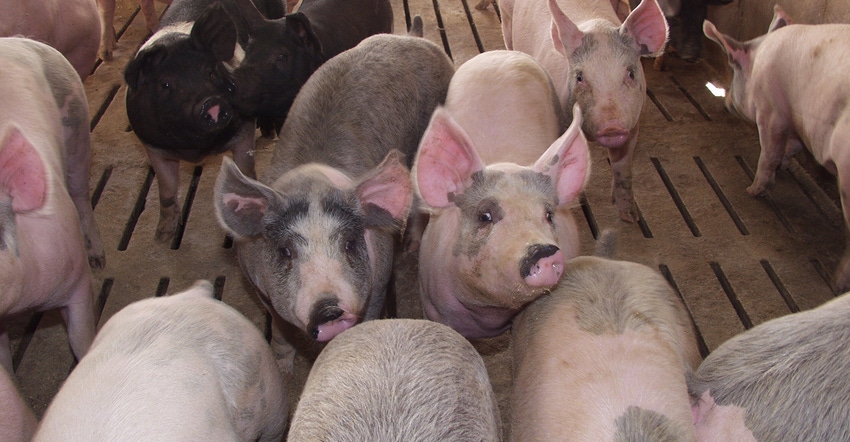Is moving pigs outdoors a temporary solution?
Hostetler says be aware that loss of body weight in pigs and changes in final carcass composition may occur.
April 28, 2020

As U.S. pork producers exhaust every effort possible to buy time while processing plants are shut down due to COVID-19, providing enough space for these growing animals remains of utmost concern. With springtime temperatures in the forecast, many producers may be considering moving pigs outdoors. According to the animal science director for the Pork Checkoff that could be a temporary fix, but the transition from modern barns — where pigs are protected from the elements and potential predators —to the outdoors will not be an easy one.
"It's critical to think through how moving pigs to an outdoor environment will affect them in every possible way," says Chris Hostetler. "It's not as simple as quickly fencing off part of a pasture and calling it good. Even nearly grown pigs will go through some level of shock going from inside to outside if proper steps aren't taken to limit downside risks."
Hostetler urges producers to consider these eight areas before moving pigs outdoors.
Determine if moving outside is really right. Is there any other way to maintain pig flow? What else could you do first to buy some more time to reach market? Feeding pigs a less-optimal diet is one way to slow down pigs reaching market weight. Could you find an open turkey, broiler and duck house that is no longer in use that could house your pigs temporarily? What are the environmental implications? (Check with your state's regulatory authority.)
Maintain good animal welfare. Pigs should only be housed outside if animal welfare is kept at a high level. Moving pigs accustomed to housing in which environment is closely regulated to outside paddocks where environment is not controlled could compromise pig well-being and health.
Use solid, substantial fencing. Sturdy penning inside barns is designed to withstand the wear of multiple turns of pigs, and pigs are accustomed to it. Market-sized pigs suddenly put out into a paddock fenced with two-strand electric fence are likely to run straight through it because they don't know what it is. So, if you use it, be sure to use it with a more substantial backing of woven wire or "hog panels" fencing.
Throw some shade. Your pigs (especially white ones) will need shade outdoors to reduce sunburn potential. It doesn't need to be hot for sunburn to occur or even fully sunny. Ideally, temporary enclosures should be entirely covered with a shade structure.
Provide ample water. As always, pigs need full access to clean, fresh drinking water at all times. Ensure that you have enough drinkers or waterers for the number of pigs.
Keep feed clean, protected. In an outdoor setting, keeping feed clean and waste to a minimum could be your biggest hurdles. Remember, your pigs are accustomed to seeing their feed in a certain way in recognizable feeders. Avoid the temptation of feeding directly on the ground as this will result in substantial waste. Metal or even wooden feeders are your best bet to keep feed dry and spoilage-free.
Consider pig-handling strategy. Most barns provide some type of "built-in" infrastructure for helping you move pigs from one pen to another or out of the barn to their next stop or market. Think about how you can move pigs outdoors while keeping pigs calm and handlers safe. What will market loadouts look like? How will individual pig treatment be done? Make effective use of any existing gates, chutes, etc.
Keep biosecurity in mind. Just because you're preparing to move pigs outside doesn't mean biosecurity should stop. It may look different outside, but it's certainly achievable with a few key steps. For example, wear dedicated, farm-specific clothing and footwear while working pigs. Configure feeders to minimize attracting wildlife. Make sure farm visitors wear disposable coveralls and foot coverings. And lastly, monitor your hogs daily for signs of illness or discomfort.
Finally, Hostetler says it's important to remember this is only a temporary option until a market can be secured, and loss of body weight in pigs and changes in final carcass composition are likely to occur, which may result in marketing discounts.
Source: National Pork Board, which is solely responsible for the information provided, and wholly owns the information. Informa Business Media and all its subsidiaries are not responsible for any of the content contained in this information asset.
About the Author(s)
You May Also Like



